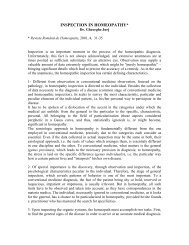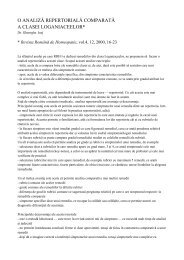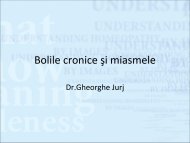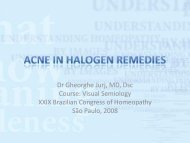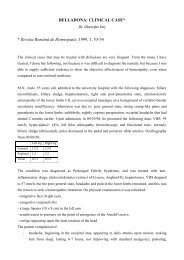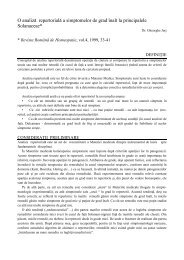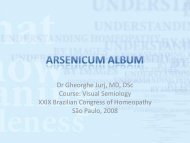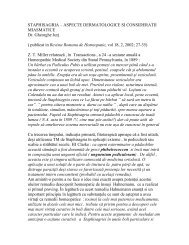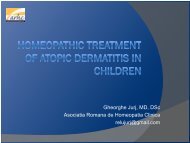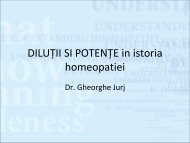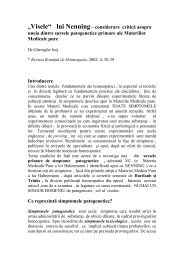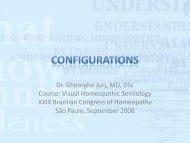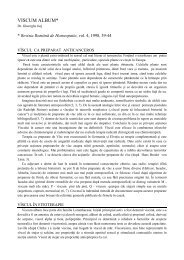Nenning's âdreamsâ - Dr. Gheorghe Jurj - Homeopatie
Nenning's âdreamsâ - Dr. Gheorghe Jurj - Homeopatie
Nenning's âdreamsâ - Dr. Gheorghe Jurj - Homeopatie
You also want an ePaper? Increase the reach of your titles
YUMPU automatically turns print PDFs into web optimized ePapers that Google loves.
Nenning’s „dreams”:<br />
Critical considerations on one of the primary pathogenetic sources of<br />
the pure materia medica*<br />
<strong>Dr</strong>. <strong>Gheorghe</strong> <strong>Jurj</strong><br />
* Revista Română de <strong>Homeopatie</strong>, 2002, 4, 30-39<br />
Introduction<br />
One of the basic pillars of homeopathy in its theoretical aspect, and directly related to<br />
the foundations of its practice, depends on the record of the data resulting from<br />
experimentations performed on healthy individuals; these symptoms constitute the<br />
pure materia medica. The latter records all the symptoms obtained from the<br />
individuals that have tested a given remedy. In other words, a number of healthy<br />
individuals submits voluntarily to test the effects elicited in the physical and<br />
psychological economy by the ingestion of a certain substance, in different dilutions.<br />
This is called a proving, and its subjects are called provers. The results are recorded in<br />
files of symptoms, and published in specialized journals and, eventually, pass into the<br />
homeopathic materia medica.<br />
The aim of the present study is to research one of the primary sources of pathogenetic<br />
symptoms, recorded as „NG” in Hahnemann’s materia medica, and later identified as<br />
Nenning, who supplied thousands of symptoms, already in the first editions of<br />
Hahnemann’s Materia Medica Pura, from writings signed by Hartlaub and Trinks in<br />
several publications of that time. In the present paper, it will be examined one only<br />
domain, „dreams”, in the source mentioned.<br />
What do the pathogenetic symptoms represent?<br />
Pathogenetic symptoms are those which result strictly from the intake of substances,<br />
usually diluted, within the setting of a homeopathic proving. Different from the<br />
toxicological symptoms, this one is an extremely sensitive domain, involving the<br />
subjectiveness of the provers, who record everything they feel in the course of the<br />
proving. Therefore, provings are rich in subjective descriptions regarding kinds of<br />
pain, sensations „as if”, conditions of aggravation and amelioration, etc. I believe that<br />
this leads straight to three basic issues.<br />
1- What does a given substance, in ponderal or infinitesimal doses, effect on a<br />
healthy human being? That is to say, the primary symptoms determined by the<br />
substance, those which depend on its primary action on the prover (e.g.,<br />
midriasis following atropine) and that constitute the invariable core of the<br />
remedy. This question leads to the pharmacologic and toxicologic effects of<br />
substances. Because of this, a significant part of the symptoms recorded in the<br />
homeopathic materia medica come from involuntary or accidental
intoxications. Data coming from toxicology are among the most certain<br />
regarding the effects of substances on human beings. A part of the<br />
pathogenetic symptoms are significantly close to the pharmacological ones,<br />
especially in the case of provings performed by the first generations of<br />
homeopaths, where the tested substances were diluted, however, still in<br />
ponderal doses, and in some cases, the amount of the substance was<br />
progessively increased, until symptoms appeared.<br />
2- What symptoms does a substance elicit in highly sensitive provers? These<br />
provers will manifest particular symptoms, even when the substance is<br />
employed in very small doses or homeopathic dilutions. Their record is<br />
essential to define the domain of specific homeopathicity (e.g., the yellow<br />
vision following digital appears precociously in sensitive individuals, but only<br />
when the intoxication is fully established in the rest). In the highly sensitive<br />
individuals, symptoms and reactions appear a while after the primary effect<br />
disappears or when the substance is repeatedly taken for long periods of time,<br />
repetitions being sufficient to elicit a reaction of the organism. All this would<br />
constitute the secondary action of the substance, which depends on the<br />
individual sensitiveness and the reactions of the sensitive organism. These<br />
symptoms are among the most important in homeopathy because, in the course<br />
of time, contributed to the deciphering of the reactional models of the<br />
remedies and later, to the homeopathic typologies.<br />
3- What symptoms are purely individual? As a consequence of the<br />
pharmacological or informational stimulus represented by the substance, the<br />
body and mind of the prover react by activating his/her own mechanisms of<br />
reaction. This kind of reactions might be called tertiary reaction, which<br />
depends particularly on the prover, supplying more information on him/her<br />
than on the substance. This is not a special sensitiveness of the individual to a<br />
certain substance, but a general sensitiveness, which determines the<br />
appearance of symptoms that reflect his/her own story and general modes of<br />
reaction. This sort of reaction is almost impossible to perceive in a single<br />
prover in one only proving, i.e. in a „horizontal” reading of all the symptoms<br />
he/she expressed in that proving. But, if we review many provings where a<br />
same individual tested different substances, i.e. a „vertical” analysis, the<br />
apparition of the same symptoms in many or all of them might be an index of<br />
his/her individual mode of reaction.<br />
<strong>Dr</strong>eams reported by Nenning in the proving of Natrium sulphuricum<br />
Upon studying the materia medica of Natrium sulphuricum, among others, I found the<br />
following symptoms in the chapter „Sleep and <strong>Dr</strong>eams” in Allen’s Encyclopaedia,<br />
attributed to the source [a2], which Allen identified as Nenning.<br />
1- Restlessness at night, which keeps her awake a long time.<br />
2- Very restless night; she wakes at times from violent headache.<br />
3- Restless sleep; he awoke often; had heavy anxious dreams, and afterwards raised<br />
much mucus (fourth day).<br />
4- When she is hardly asleep she starts up, without waking up entirely.<br />
5- <strong>Dr</strong>eams often, but does not remember what.
6- <strong>Dr</strong>eams of gardens, flowers, delightful picnics (after eight days).<br />
7- <strong>Dr</strong>eam that she bought beautiful bouquets of flowers in the market (fourth night).<br />
8- <strong>Dr</strong>eam of a wedding procession that passed by her (seventh night).<br />
9- <strong>Dr</strong>eam of a lottery; he saw the numbers which he had taken.<br />
10- Only anxious dreams; for instance, that she poured boiling lard into the fire.<br />
11- Anxious dream that priests had discovered that she had committed crimes.<br />
12- <strong>Dr</strong>eam that a gentleman she knew lay sick in her house.<br />
13- <strong>Dr</strong>eam that wood was being floated down the neighboring stream, which might be<br />
the cause of much damage.<br />
14- <strong>Dr</strong>eam that she was sailing on the Danube, and was very much afraid.<br />
15- <strong>Dr</strong>eam of a great expanse of water, into which her daughter went, and then cried<br />
for help.<br />
16- <strong>Dr</strong>eam that her daughter had been struck by paralysis, which frightened her so<br />
that she woke covered with perspiration.<br />
17- Anxious dreams of falling from a height, etc., which made her start up.<br />
18- <strong>Dr</strong>eam that she was flying in the air, and always feared to fall to the ground.<br />
19- <strong>Dr</strong>eam, before midnight, that she was thrown from a carriage.<br />
20- <strong>Dr</strong>eams that an acquaintance was going to cut off the great toe of his right foot;<br />
the fear of it awoke him, and he felt a violent pain, as though knives were sticking in<br />
this toe, for one minute, after midnight.<br />
21- <strong>Dr</strong>eam that her daughter had vexed her (third day).<br />
22- Vexations dream that a young gentleman of her acquaintance slighted her.<br />
23- <strong>Dr</strong>eam that he was much hurt and provoked because he had been insulted,.<br />
24- <strong>Dr</strong>eam that insults had excited him so that he began to fight.<br />
25- <strong>Dr</strong>eam of a mob fight, in which he became engaged.<br />
It is immediately evident that many of the provers are female; dreams are many,<br />
agitated, anxious, extremely personal. Some themes may be distinguished:<br />
* Sleep and dreams restless, with starting.<br />
* <strong>Dr</strong>eams of offence, striking, insults, fights.<br />
* Anxious dreams: guilt (crime); falling; height; burning, etc.<br />
* <strong>Dr</strong>eams related to „water”: immersion, journeys.<br />
* <strong>Dr</strong>eams with gardens, flowers, happiness, etc.<br />
* <strong>Dr</strong>eams with misfortunes, associated to relatives or others.<br />
A quick survey of the contents of these dreams immediately brings the problem<br />
mentioned above: are they generated by the intake of the substance, even in<br />
homeopathic dilutions? Can we speak here of a primary action of the substance? Or<br />
is it possible that the substance aroused subconscious motions in the provers, ruled<br />
by the hidden algorythms of the structure of their own personality, due to the fact that<br />
these provers were highly sensitive to the substance (secondary action)? Or, on the<br />
contrary, do these dreams reflect the obsessions and subconscious load of the<br />
provers, which were revealed on the occassion of the proving, as an inespecific<br />
reaction to a stress, thus, unrelated to the specific quality of the stimulus (the proven<br />
substance), but to the general stress represented by the proving (tertiary reaction)?<br />
<strong>Dr</strong>eams reported by Nenning in other remedies.
In the proving of Magnesium muriaticum, Nenning is mentioned by Allen as the<br />
source [a5].<br />
1- Frequent vivid, but unremembered dreams.<br />
2- Pleasant dreams of marriages, dances, money.<br />
3 - <strong>Dr</strong>eams of journeyings.<br />
4- <strong>Dr</strong>eams of much water.<br />
5 - <strong>Dr</strong>eams full of shame.<br />
6 - Many anxious dreams.<br />
7 - She became anxious in a dream about work that she could not accomplish.<br />
8 - <strong>Dr</strong>eam that she became confused in a forest, and for a long time could not find her<br />
way.<br />
9 - An anxious dream; she was lying in a strange house, where rubbish was<br />
constantly falling upon her; she tried to cry out and could not, because there was too<br />
great heaviness on the chest (nightmare), (after two days).<br />
10 - <strong>Dr</strong>eams of a fire in the vicinity, at which she was frightened, cried, and woke<br />
with wet eyes, and weak hands and feet.<br />
11- If she fell asleep, all sorts of things came to her, frightful dreams of falling, and<br />
the like.<br />
12 - Frightful dreams; that she was pursued by robbers; that she burned her hand by<br />
washing, etc.<br />
13 - Disgusting and frightful dreams; that some one cut away one side of her face;<br />
that a skin was being taken from a dead body and the like.<br />
14 - <strong>Dr</strong>eam that some one came to murder her; that she jumped from a window, and<br />
awoke in fright.<br />
15 - <strong>Dr</strong>eams of deaths.<br />
In Niccolum, Nenning reports the following dreams:<br />
1- Sleep always good, but with frequent though unremembered dreams.<br />
2 - Constant, confused, visionary dreams while half awake (second night).<br />
3 - Voluptuous dream (eighth night).<br />
4 - <strong>Dr</strong>eam that she saw coming a man with whom she was acquainted, but whom she<br />
took for the devil, but afterward recognized, at which she was as happy as she had<br />
previously been frightened (second night).<br />
5 - <strong>Dr</strong>eam that she lost a tooth, which caused her very great unhappiness (eighth<br />
night).<br />
6 - Frightful dreams; she seemed to see the head of an acquaintance cut off,<br />
whereupon she woke in perspiration and anxiety (fourth night).<br />
7 - <strong>Dr</strong>eam that she had pains in the right arm; she tried to rub it but could not; tried to<br />
move it and could not, whereupon she was very much istressed (twentieth night).<br />
8 - <strong>Dr</strong>eam that she almost fell from the loft, and could with difficulty hold on,<br />
whereupon she woke in fright (second night).<br />
9 - <strong>Dr</strong>eam that her mother fell into a cistern and was drowned, whereupon she woke<br />
trembling and weeping (sixth night).<br />
10 - <strong>Dr</strong>eam that he ran after men, bruised and very much injured himself (first night).<br />
11 - <strong>Dr</strong>eam that her brother, living at a distance, visited her, and she was very happy<br />
(first night).<br />
12 - A dream of tombs, which he himself inhabited; afterwards a voluptuous dream<br />
(fifth night).
13 - <strong>Dr</strong>eam that persons she knew were dead; she wept.<br />
14 - <strong>Dr</strong>eam of quarrelling with a view to death and murder; she tried to cut off the<br />
finger of an acquaintance, but could not accomplish it in spit of every effort (seventh<br />
night).<br />
14- <strong>Dr</strong>eam that she had quarrelled with an acquaintance (sixth night).<br />
15 - <strong>Dr</strong>eam of quarrelling and struggling with her husband, who lived at a distance,<br />
and who had just arrived, whereupon she woke (third night).<br />
In Oleum animale aethereum, Nenning [a1] reported:<br />
1- <strong>Dr</strong>eam of dead persons (second day).<br />
2 - Anxious dream of murders.<br />
3 - Unremembered dreams.<br />
In Phellandrium aquaticum [a1]:<br />
1- <strong>Dr</strong>eams of lightnings, with great fright(second day).<br />
2 - Pleasant dreams of gardens, parties, excitement, etc.<br />
3 - Various unremembered dreams.<br />
4 - <strong>Dr</strong>eam of a robbery, in which he received many blows.<br />
In Plumbum metallicum [a4]:<br />
1- Frequent dreaming, with sound sleep (first night).<br />
2- <strong>Dr</strong>eams of stealing fruit in a garden (first night).<br />
3- Confused anxious dreams(third day).<br />
4 - Heavy frightful dreams of falling (first night).<br />
In Sarsaparilla officinalis [a6]:<br />
1- He dreams, towards morning, several white spectres came into his room and near<br />
his bed;he was at first shocked and very much frightened, but recovered himself, and<br />
struck them down with both his fists, so that they all fell to the ground;after which his<br />
nose bled, and it woke him, and he thought he had struck himself on his nose (third<br />
day).<br />
2 - He saw in his dream several long ago deceased relations (twelfth day).<br />
3 - Heavy dreams, full of frights, but cannot recollect what (fifth and sixth days).<br />
4 - <strong>Dr</strong>eams of the business of the day before (sixth day).<br />
5 - <strong>Dr</strong>eams she is sleigh riding and the sleigh upsets;she starts violently and wakens<br />
up (eighth day).<br />
6 - Lascivious dreams, without erections (second and tenth days).<br />
7- <strong>Dr</strong>eams of vexation.<br />
8 - <strong>Dr</strong>eams of what was talked about the day before.<br />
In Sulphur [a3]:<br />
1- Frightful, anxious dreams of danger of death, and of dead people.<br />
In Zincum metallicum [a8]:
1- Vexatious, or quarrelsome or sad dreams.<br />
Comparing these symptoms with the reported in Natrium sulphuricum it is easy to<br />
observe the reappearance of common themes, as if the dreams belonged to the same<br />
persons, with similar – not identical - subconscious dynamics. Almost indifferently to<br />
the substance employed in the proving, the themes reappear, which brings the<br />
problem whether the dreams may truly be attributed to the substance proved (as<br />
primary or secondary action) or are exclusively individual. To elucidate this, it would<br />
be very useful to know what the dreams of the provers were before any proving.<br />
Provings reported by Nenning.<br />
When I began this study, I knew nothing about Nenning and his contribution to the<br />
development of homeopathy. I searched in all bibliography available and it became<br />
evident that Nenning is one of the more copious sources of pathogenetic symptoms in<br />
the history of homeopathy, obtained in many provings performed in the early years of<br />
this discipline:<br />
<strong>Dr</strong>. Roth counted more than 11,000 symptoms supplied by him in<br />
different materia medica (including Hahnemann’s), published<br />
especially in Hartlaub & Trinks between 1828-1836”. (19)<br />
A simple enumeration of the remedies proven is impressive; in many cases he was the<br />
first to prove them, including policrests. In other remedies, Nenning made significant<br />
contributions, included in Hahnemann’s Materia Medica Pura and Chronic Diseases.<br />
The former contains approximately 11,400 symptoms originated by this source. (27)<br />
Below, I have listed his most important contributions to the provings of several<br />
remedies. The reason is double: first, to highlight the extraordinary extension of his<br />
contribution to homeopathy; then, to bring an example on the way how the early<br />
homeopaths reported their activity.<br />
Natrium sulphuricum<br />
Proved by <strong>Dr</strong>. Schreter, in Lemberg, Galicia; 1832, in Hartlaub’s Annalen, vol. 111,<br />
No 4 and „carefully and praiseworthy” – stated C. Hering – by Nenning in Bohemia,<br />
in 1833, vo. 4 No 4. Similarly, Boericke mentions Nenning and Schlusser, 1832, but<br />
this is not a proper proving, rather, a clinical discussion of salts in the biochemistry of<br />
the organism. (2)<br />
Natrium carbonicum<br />
In the 3rd edition of the Chronic Diseases Hahnemann added about 625 symptoms to<br />
the initial list of 308, following the provings of Nenning and Schretter. (19)<br />
Oleum animale aethereum<br />
Proving performed by Nenning, Schreter and Trinks, Hartlaub and Trinks, R.A.M.L.,<br />
vol. 2. (1)
Magnesium carbonicum<br />
Published in Hahnemann’s Chronic Diseases, IV, 135, following Hartlaub & Trinks,<br />
Reine Arzneimittellehre, „Most of the symptoms, 801 in the original form, come from<br />
Nenning” (19). (29, 30).<br />
Magnesium muriaticum<br />
Proving made by Hahnemann, with additions from Nenning, Hartlaub and Trinks'<br />
Arzneimittellehre, vol. 3, p. 237. ) (1, 8, [29,30] )<br />
Magnesium sulphuricum<br />
Hartlaub and Trink's Annalen, vol. 4, p. 466.<br />
Manganum aceticum<br />
Nenning , Hartlaub and Trinks' Annalen, vol. 2, p. 20.<br />
Muriaticum acidum<br />
Most of the symptoms in the first two editions of the Chronic Diseases were obtained<br />
by Hahnemann and his assistants. Most of the additions to the 3rd edition come from<br />
Nenning. (19)<br />
Aethusa cynapium<br />
Nenning, Prak. Mitth., 1828. „Introduction to the Materia Medica of <strong>Dr</strong>. Nenning,<br />
from Germany” (25) – here it is evident the mistake of O’Connor, repeated each time<br />
he mentions him. In that time, Bohemia was a part of the Austro-Hungarian Empire,<br />
not Germany. This mistake appears also in the writings of other authors (7, 24).<br />
Achilea millefolium<br />
Nenning: Annalen hom. Klinik, V. 4, p. 344.<br />
Ammonium muriaticum<br />
Hartlaub in Annalen, 1833.<br />
Ammonium carbonicum<br />
Proved by Nenning on many people; his 479 symptoms, including some of the editor,<br />
appeared in Hartlaub & Trinks’ Arzneimittellehre. In the 2nd edition of the Chronic<br />
Diseases these observations were supplement by some new ones made by<br />
Hahnemann, to a total of 789. (19)<br />
Betula alba<br />
Nenning: A.H. Z., V. 20, p. 130) (3)<br />
Bovista lycoperdon<br />
Proved by Nenning and two oher provers, 640 symptoms from this source appeared in<br />
Hartlaub & Trinks’ Arzneimittellehre. According to Hughes, „it is one of the vicious<br />
symptom-lists of the sub-Hahnemannic epoch, without any information as to subjects,<br />
doses, or relations between symptoms.") (18, 29,30).<br />
Niccolum-met + -c<br />
Nenning: Hartl. u Trinks, Annalen, V. 3, p. 353. Hartlaub (III. 3) in 1832, published a<br />
proving of nickel made by Nenning on several people, without mentioning the
preparation employed. It may be supposed that it was not pure. Trinks’ statement that<br />
it was made with a carbonate cannot be believed. (15, 20)<br />
Natrium carbonicum<br />
Proved by Nenning and Richter, Hartlaub & Trinks, R.A.M.L., vol. 2, p. 138. „Has a<br />
special affinity for the breasts, especially the right. Pains appear in the nipples each<br />
time the child is put to feed. Pains extend inwards and to the back, towards the<br />
humerus and the sacrum”. (23)<br />
Baryta carbonica<br />
Hahnemann added in the 1835 edition of the Materia Medica Pura many symptoms<br />
reported by Nenning in Hartlaub.<br />
Castoreum canadense<br />
Mentioned in Allen, following Hartlaub & Trinks’ Annalen, vol. 3, p. 314.<br />
Causticum<br />
The proving of Causticum has a story of its own. In Fragmenta de viribus<br />
medicamentorum Positivis, sive in sano corpore humano observatis (1805),<br />
Hahnemann published thirty symptoms obtained by him with a substance called<br />
„Acris tinctura”. In the first and second editions of the Materia Medica Pura a more<br />
extensive proving appears of the same preparation, now called „Aetzstoff Tinctur-<br />
Tinctura acris sine Kali”. To this proving (which in its final form contains 307<br />
symptoms) belong symptoms from Becher, Franz, Hartmann, Hermann, Hornburg,<br />
Langhammer and Stapf, besides more than 100 observations by Hahnemann. In the<br />
3rd edition (1833), the remedy was not included, this is why it cannot be found in<br />
Dudgeon’s translation. However, in 1830 Hahnemann had transferred it to the<br />
Chronic Diseases, where 1014 symptoms are listed, the new ones coming by Rummel<br />
and himself. Now it is called „Aetzstoff” or „Causticum”, and it is prepared in a<br />
different way. In the 3rd volume of their Arzneimittellehre, Hartlaub and Trinks,<br />
mentioning Nenning, include 9 symptoms of the older and 70 of the new preparation.<br />
(12)<br />
Chelidonium majus<br />
Nenning: Hartl. u Trinks, Mat. Med., V. 3) (3)<br />
Gambogia<br />
„Nenning proved this remedy on many subjects, female, in doses of 30 drops of pure<br />
tincture, 25 drops in the first dilution, 20 in the second and 25 in the third, does not<br />
supply data on the provers and the dose each one took, nor indicates which symptoms<br />
appear in each prover”. (19) The symptoms appear in Allen’s Encyclopedia, vol. 4, p.<br />
373. (1)<br />
Strontium carbonicum<br />
Nenning, Schreter, Seidel, Trinks and Woost, Hartlaub and Trinks, R. A. M. L.<br />
Tabacum
The primary provers were Nenning, Schreter, Hausbrand, Hartlaub and Trinks , Mat.<br />
Med.; Seidel's Collection, A. H. Z., vol. 12, p. 150; Allen's Encyclopedia. Nenning –<br />
number of provers unknown, method unknown, employed Hungarian tobacco. (29)<br />
Alumina<br />
Hartlaub and Trink's, Arzneimittellehre, II, 80. Contains 979 symptoms from 4<br />
observers, Hartlaub, Nenning, Schreter, Trinks obtained with the first and sixth<br />
triturations. (19)<br />
Indigo tinctoria<br />
Was proved by Lembke, A. h. Z., xlv, 338 and NENNING : Annal. Hom. Klinik, V.<br />
3, p 229.<br />
Graphites<br />
The proving of Graphites appeared in the first edition of the Chronic Diseases, with<br />
590 symptoms. It was later proved by Nenning, on many people, and Hartlaub. In the<br />
2nd edition of the Chronic Diseases, Hahnemann added 200 new symptoms and also<br />
some reported from Rummel and Kretchmar, to a total of 1,144 symptoms. (1, 17, 19)<br />
Kalium carbonicum<br />
Hahnemann published a proving in the fist edition of the Chronic Diseases with 938<br />
symptoms. In the 2nd edition, the list had increased to 650, some of them reported by<br />
Hartlaub and Goullon, and many by Nenning.<br />
Sarsaparilla officinalis<br />
Nenning : Hartl. Mat. Med., V. 2.<br />
Tartaricum acidum<br />
Nenning: Prakt. Mittheil, 1827, p. 27. Later, mentioned by Allen.<br />
Jalapa<br />
„Painful diarrhea in children, with violent restlessness and crying” – Nenning. (4)<br />
Dulcamara<br />
Hahnemann added symptoms reported by Nenning (mentioned as „NG”) in the<br />
Chronic Diseases. (5)<br />
Euphorbium officinarum<br />
Proving performed by Hahnemann, Langhammer, Wislicenus and Nenning. (19)<br />
Sarsaparilla<br />
In Materia Medica Pura, vol. IV, 42 symptoms by Hahnemann and 111 by others.<br />
Nenning performed later a proving for Hartlaub & trinks’ Arzneimittellehre, vol. 2,<br />
that contains 347 symptoms. It was added to the 3rd edition of the Chronic Diseases.<br />
(5, 17, 19)<br />
There are further mentions of Nenning in other remedies, from the first editions of<br />
Hahnemann’s works to the main pure materia medica: Phosphorus, Sulphur, Silicea,
Sulphuric acidum, Zincum , Plumbum metallicum , Arsenicum album, <strong>Dr</strong>osera, Ipeca,<br />
Laurocerasus, Moschus , Paris, Sabina. Secale, Carbo animalis, etc . And probably,<br />
some symptoms of Ratania (18), Silica marina, Kalium iodatum and Cantharis.<br />
(1,5,19,17)<br />
Reactions to Nenning’s provings<br />
Upon the first time that Hahnemann employed provings published by Hartlaub &<br />
Trinks (Alumina, in the Chronic Diseases), he remarked:<br />
„This two letters (NG), purely anonymous, indicate the person who supplied most of<br />
the symptoms in the Annalen, although many times expressed in a negligent, diffuse<br />
and indefinite manner. I merely extracted from his provings what is useful, believing<br />
that it is a person careful and trustworthy; however, in a field as difficult and<br />
sensitive as the testing of remedies is, it would be unforgivable if the homeopathic<br />
public were to inconditionally trust an unknown person called by two letters, such as<br />
Ng”. (11)<br />
It might be that Hahnemann „was injustifiedly prejudiced and reacted against the<br />
provings of Nenning, which seem to have been consciously performed, although not in<br />
strict conformity to the Hahnemannian method”. [Brit.J. of Hom, XXXV, p. 106,<br />
commentary of Hughes on the Organon] (10)<br />
Similarly, it seems that the note to chapter 143 of the Organon, exclusively in the 5th<br />
edition, allude to Nenning’s provings, who apparently paid his provers:<br />
„Recently, it has become customary to trust the testing of remedies to unknown<br />
persons, who are paid for their labor; data thus obtained are being published.<br />
However, in this way the most important work of all, that has as its mission to form<br />
the true and only pillars of the art of cure, and which requires the maximum of<br />
certainty and moral trustworthiness, seems to me – and I regret to say this – becomes<br />
dubious and uncertain, concerning its results, loosing in this way all value.” (13)<br />
This note of Hahnemann raised strong suspicious against the source mentioned, up to<br />
the point that some authors, as the ones that compiled the Repertory Cypher,<br />
eliminated all symptoms originated in it. (17, 19) Roth examined Nenning’s provings,<br />
which he disbelieved, calling them „a factory of symptoms”, and considered his<br />
contributions dubious. (18, 27)<br />
In his writings, Hughes makes an implicit criticism (although many times he writes<br />
sentences such as „this proving was performed by Nenning in his usual manner,<br />
without indicating the doses, provers, etc.”), but also explicit:<br />
„Nenning proved Laurocerasus in his usual manner, i.e. on the employees of his wife,<br />
who were paid to do so. He reported every trifling deviation observed, and in this way<br />
he overloaded the list of symptoms with countless stitches here and there, rumblings<br />
in the abdomen, changing of seats and others of this kind, which are evidently not<br />
produced by the remedy, but incidental normal conditions of any individual.
Hahnemann only did was to extract from the contributions of this surgeon...tightly<br />
restricting their use.” (18)<br />
Even though, he admits Nenning’s merits:<br />
„It seems, however, that Nenning’s symptoms were obtained in a right manner, i.e.<br />
through testing in healthy individuals, yet, the paying of the provers and the lack of<br />
discernment upon taking the records have put some shadows on the results. Even<br />
though, I do not believe that it is justified to remove them all. The only thing needed<br />
by these symptoms is their clinical verification, to be tested as materials to verify the<br />
rule similia similibus curentur. If in this way, they confirm their reliability, we may<br />
consider them as admissible in the materia medica.” (18)<br />
On the other hand, eminent homeopaths, such as Boenninghausen, Wilson and Hering<br />
gave him a vote of confidence:<br />
„accepting the contributions of Nenning as satisfactory as the ones of other<br />
observers. Not one affirmation against him has come from this side. Therefore, we<br />
may accept the contributions of Nenning or, at least, to temporarily consider them as<br />
good and valuable additions.” (18)<br />
Hering would call him, once and again, „the conscious and praiseworthy Nenning”<br />
and admitted that he had verified many symptoms in his clinical practice, e.g. „Raue<br />
and Hering: a certain form of sciatica, cured with Nat-s in the second dilution,<br />
according Nenning’s proving”. (17, 24) Or, he trusted his clinical authorithy in his<br />
Guiding Symptoms of Our Materia Medica, e.g. in Sabina, Secale (hypermenorrhea),<br />
Rhus toxicodendrum (epistaxis), Pulsatilla (threaten of abortion), Colocynthis<br />
(flatulence after falling; complicated kidney colics), Sulphur (ophtalmia), etc. (17)<br />
Commenting on the proving of Ammonium muriaticum, Hering states, „the first<br />
prover was the much criticized Nenning, whose masterly provings were published by<br />
Hartlaub”. (17)<br />
Similarly, time allowed to verify many of the symptoms of his provings, so that „the<br />
accuracy of those symptoms was confirmed by the doctors who employed them”,<br />
„obtaining spectacular cures”. (26, 27)<br />
For instance, Farrington reports one such cure in cases of amenorrhea with<br />
Manganum aceticum 3C, after researching other remedies, which he chose on the<br />
grounds of symptoms described by Nenning. (9)<br />
Who was Nenning?<br />
The history of the anonymous provings under „Ng”, dating from Hahnemann’s time,<br />
has it own story. It was Hering who explained who this anonymous source was:<br />
„... a surgeon, from the area of Budweis, in Bohemia, a candid, right man, not too<br />
much learned but with good intentions, for which was known by everybody. According<br />
to the laws of the country, he was allowed to practice only surgery. But a paralysis of<br />
the right hand hindered him to continue in his profession. His wife, then, opened a
school of embroidering to sustain the family. Nenning discovered homeopathy and<br />
immediately became an ardent admirer. It was then that he had the great idea to<br />
contribute to this cause, by making provings on the girls which worked in his wife’s<br />
embroidery workshop. He succeded to convince them. Unluckily, he could only get in<br />
touch with Hartlaub, from Leipzig, instead of Hahnemann himself.<br />
In that time, all Austrian citizens were forbidden, by stric laws, to send any printable<br />
materials outside the boundaries of the Empire. Therefore, not only Nenning, but all<br />
Austrian subjects, would appear in books only with their initials.” (18)<br />
So, Hahnemann’s objection on Nenning’s anonymacy was unfounded, and is<br />
historically explained. Moreover, as soon as it became possible to publish abroad,<br />
Nenning himself supplied an explanation, in the Allgemeine Hom. Zeitung (1839):<br />
„... if I performed many provings, and, as it has been remarked, I reported many<br />
symptoms, this, in my opinion, should have awaken more sympathy than derision. The<br />
legacy of Hahnemann, which I believe it is not merely to take profit, but to commit us<br />
to work, awoke my enthusiasm and, with the active support of Hartlaub, it was<br />
possible to do what I did, which at times surprised Hahnemann himself. A number of<br />
people, relatives and friends, was gather to perform provings, being rewarded with<br />
food and money. Together with them, two of my children also participated, and with<br />
full confidence in the honesty of all, I gave them different remedies and recording<br />
everything they reported. It was a matter of conscience for me not to omit the least<br />
detail, this is why frequent repetitions appeared, which I admit, because I thought that<br />
only in this way the field of action of a remedy could be best recognized”. (18)<br />
Being one of the main suppliers of pathogenetic symptoms in the history of<br />
homeopathy, Nenning’s exemplar modesty is almost legendary. Keeping some<br />
reserve concerning the manner in which he performed the provings, Nenning may be<br />
considered as one of the unknown pioneers among the anonymous devotees who<br />
tried, with the best of will, although not always with the desired exactitude, to offer a<br />
factual foundation to homeopathy.<br />
Instead of a conclusion...<br />
Incursions in the history of homeopathy as the present one, focused on a single<br />
primary source and a restricted field, dreams, cannot lead to firm conclusions, which<br />
would be shallow and inconsistent.<br />
The problems related to the reliability of the primary source of the pathogenetic<br />
symptoms „Nenning” will remain; however, the endorsement by several prominent<br />
homeopaths, who trusted and clinically verified these symptoms, helps to give<br />
significant credit to it.<br />
However, all the discussion above reminds us of the intrinsic fragility of dreams as a<br />
feature of provings. As it could be seen, dreams, precisely because they reflect the<br />
individual subconscious dynamics, are subjected to multiple influences, among which<br />
a proving, which may give rise to individual themes; but it is impossible to distinguish<br />
between these motions and the direct action of the remedy.
An exaggerated emphasis has been recently placed on „dream provings” (31, 32),<br />
which are hard, if not impossible, to verify as reliable homeopathic symptoms. I<br />
believe that this fad is problematic and inconsistent as a ground for accurate<br />
homeopathic prescriptions. It is highly probable that the dreams appearing in provings<br />
are nothing but the reiteration of subconscious themes lying in the mind of the prover.<br />
My intention is not to call to abolish dreams as a pathogenetic realm but, on the<br />
contrary, to call attention to them. As a general idea, a possible path is to rate new<br />
dreams that first appear in a proving, as pathogenetic symptoms (due to the primary or<br />
secondary action of the tested remedy). If dreams are repeated or existed in the prover<br />
before the proving, or reappear in several provings performed by the same individual<br />
(as it seems to be the case of Nenning’s symptoms), it is probable that they reflect the<br />
tertiary reaction of the individual, essential in his/her personal history, i.e. they are<br />
personal dreams, and it is hard to judge, in this case, on the effects of the tested<br />
remedy. Whenever dreams appear in a proving, they have to be taken systematically<br />
in consideration. They reflect subtle modifications in an individual’s economy, due to<br />
a stimulus that reveals deep strata of disorder. Certainly, such dreams, even if<br />
personal, cannot be ignored in the course of a homeopathic consultation.<br />
The main themes around which the psychism of an individual gravitates may be<br />
revealed in a proving or a disease. And these themes may be significant in the field of<br />
the homeopathic typologies. However, their interpretation, as meaningful or not, in<br />
the course of a homeopathic consultation, depends on the subtleness of their details,<br />
but this is not the aim of the present paper.<br />
To conclude, it cannot be omitted a mention to the merit of those devoted to<br />
homeopathy, virtually unknown, who did all they could for the advance of<br />
homeopathy, and no matter criticism and doubts, effected significant contributions to<br />
the history of homepathy. This is the case of the anonymous „NG” of the first editions<br />
of Hahnemann’s Materia Medica Pura and Chronic Diseases, later identified as<br />
Nenning, the devoted surgeon of Bohemia.<br />
Bibliographical sources<br />
1. ALLEN T. F., Encyclopedia of Pure Materia Medica<br />
2. BOERICKE W., The Twelve Tissue Remedies of Schussler<br />
3. BRADFORD T.L. , Index of Homoeopathic Proving, Philadelphia 1901<br />
4. BUCK H., The Outlines of Materia Medica, Londra, 1865<br />
5. BURT W. H., Characteristic Materia Medica<br />
6. BURT W. H., Physiological Materia Medica, Chicago 1881<br />
7. CHOUDHURI N. M., A study on Materia Medica, Calcutta 1929<br />
8. CLARKE J. H., Dictionary of Practical Materia Medic<br />
9. FARRINGTON E. A., Lesser Writings (with Therapeutic Hints and Some Clinical Cases)<br />
10. GIBSON D. M., Studies of Homoeopathic Remedies, Londra, 1987<br />
11. HAHNEMANN S., Chronic Diseases, trad eng, ed 3, 1846<br />
12. HAHNEMANN S., Materia Medica Pura, trad engl Dudgeon , cu comment Hughes,<br />
13. HAHNEMANN S., Organon al artei vindecarii, trad rom, ed Marineasa, Timisoara 2001<br />
14. Hahnemannian Advocate 1896 Volume XXXV Chicago No 1<br />
15. Hahnemannian Monthly, The (_Hahn_Monthly)Vol. I. August 1865 - July 1866<br />
16. HEMPEL C. J., A New and Comprehensive System of Materia Medica Vol 1 and Vol , 1864<br />
17. HERING C., Guiding Symptoms of our Materia Medica, Calcutta, 1971<br />
18. HUGHES R. and DAKE J. P., A Cyclopaedia of <strong>Dr</strong>ug Pathogenesy<br />
19. HUGHES R., A Manual of Pharmacodynamic, 1867
20. LEESER O., Text book of Homoeopathic Materia Medica, Stuttgart, 1932<br />
21. MATHUR K. N., Systematic Materia Medica of Homoeopathic Remedies, New Delhi, 1972<br />
22. MOHANTY N., Text Book of Homeopathic Materia Medica,1994<br />
23. MURPHY R., Homeopathic Remedy Guide<br />
24. NARASIMHAMURTI K. L., Handbook of Materia Medica and Therapeutics of Homeopathy<br />
25. O'CONNOR J., The American Homoeopathic Pharmacopoeia<br />
26. Organon, The : A quarterly Anglo-American Journal of Hom. Medicine and Progressive<br />
Collateral Science (_Organon) 1878, nr 1.<br />
27. SHERR J., The Dynamics and Methodology of Homoeopathic Provings<br />
28. VARMA P. N. AND INDU VAID, Encyclopaedia of Homoeopathic Pharmacopoeia<br />
29. VERMEULEN F., Prisma, 2002<br />
30. VERMEULEN F., Synoptic Materia Medica ed 2, 1998<br />
31. Homoeopathic Links , autumn,1995<br />
32. Homoeopathic Links , spring 1999




